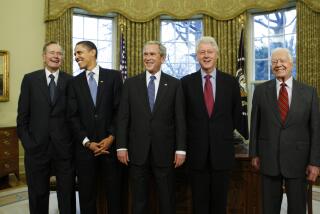Lecturers Make Big Money Where Their Mouth Is
- Share via
WASHINGTON — Newspaper columnist Jack Anderson hunkered down over the podium, enumerating the dangers of the world and bringing his audience to the very edge of Armageddon. Then, like a spellbinding evangelist who gives a picture of hell and a glimpse of heaven, he told them how it could all be avoided.
The audience rose to its feet in applause.
It was, of course, a good speech. But to this audience it was also a free sample.
“In some ways, Jack Anderson is a throwback to the inspirational speaker. He’s a master at combining theater and fact,” said Dan Tyler Moore, director of the International Platform Assn.
The IPA is considered by many the marketplace of the lecture circuit, and Anderson, as its president, was giving the closing address of its annual convention. He was also giving his audience--made up of club presidents, association chiefs, program directors and lecture organizers--an example of why he commands $10,000 per speaking engagement.
The IPA feeds public speakers to the lecture circuit, and demand is growing.
Gratis Speakers
Anderson spoke gratis to the convention, as did journalist Andrea Mitchell, businessman Malcolm Forbes Jr., Watergate notable G. Gordon Liddy and former CIA Director Stansfield Turner, each of whom usually garner well over $7,000 a speech.
In all, 38 major names addressed the meeting of those who have made the lecture circuit a $2-billion-a-year industry.
“This could be called the great golden age of speaking,” says Moore, who returned from World War II as chief of American counterintelligence and began speaking on espionage. “The field is open to anyone with an expertise and rhetorical skill. And with literally thousands of clubs and organizations around the country, the voracity of the medium has never been stronger.”
Moore said he expected television to wreck the lecture business, but it has done the opposite. The aura of celebrity that TV gives people has changed the market, he says. “People want to see and be near famous people. Now anyone with a familiar name can with a little effort turn it into cold hard cash.”
Henry Kissinger does it to the tune of $20,000 a speech. So does radio personality Paul Harvey. Journalists Sam Donaldson and William F. Buckley both pull in $15,000 a speech. Nixon, Ford and Carter earn $10,000 to $15,000 for a one-hour speech. “And due to the airplane,” Moore says, “these people speak without it interfering with their careers.”
Liddy, whom Moore brought into the lecture circuit, is a successful businessman. By speaking four times a week, he adds $1.5 million to his annual income.
Enticed Amateurs
Fees have gone up over tenfold for top speakers in the last 15 years according to Moore. A decade ago, news columnist Drew Pearson, Anderson’s mentor, pocketed $750 a speech. Other “big names,” such as Art Linkletter and TV and radio personality Ted Mack, earned comparable fees.
The lucrative field has enticed thousands of amateurs onto the lecture circuit. A prominent event at the annual IPA convention is the Speaking Ladder, an open competition of amateur speakers, which can mean increased bookings and fees for the competition’s winners and finalists.
Said David Best, one of the ladder’s organizers: “The ladder is our way to feed more people into the lecture business. We’re literally feeding them to the hundreds of program chairmen in the audience . . . . The competition won’t make anyone a millionaire, but winning it looks darn good on a resume.”
For 15 years, Delmas Wood Jr. had been speaking for no money on the issue of motivation. After winning the ladder last year, his fee climbed to $750 a speech, and he’s been named the public-speaking instructor at the National Institutes of Health. “I have all the speaking I can possibly take right now,” Wood says.
More to Read
Sign up for Essential California
The most important California stories and recommendations in your inbox every morning.
You may occasionally receive promotional content from the Los Angeles Times.












